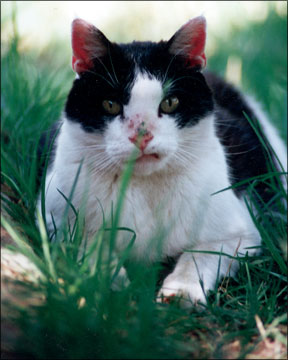The warmer weather brings sunshine, fresh breezes, singing birds – and bugs. Maybe youre the sort of person who encourages your cat when she swipes at a moth, catches it, plays with it and then devours it. Or maybe you cringe when your cat pounces on a beetle and starts crunching on it. Whatever kind of person you are, its 288 likely that you wonder if its safe for your cat to eat bugs. The answer depends on what kind of bug youre talking about. “We had 116,000 new cases in 2006 through our animal poison control hotline,” says Steven
Cats Just Want to Have Fun
Cats chase and eat bugs because they love to play with small moving objects. Is there any nutritional value in eating bugs? “Not much,” says Dr. Hansen. “But an insects exoskeleton does provide a bit of fiber.”
Most bugs are safe for your cat to sample. These include nonbiting ants and flies, most beetles, cockroaches, centipedes and moths and common household spiders. “Many people are worried about cats toying with or chewing on ant traps,” says Dr. Hansen. “This is usually not a problem, because the concentration of insecticide in these traps is very low and should not affect your cat.”
Beware of Bad Bugs
If at all possible, keep your cat away from stinging insects, such as yellow jackets, wasps and hornets. Most stinging insects will not go after cats unless they are provoked. But if you see your cat playing with a bee or other stinging insect inside your home, get her away from it and isolate her inside a closed room. Leave a window open for the insect to escape, or kill it with a fly swatter.
“Bee stings are very painful and the toxins can cause very serious consequences for your cat ,” says Dr. Hansen. The signs of a sting include acute swelling and redness around the cats nose or face. Your cat may yowl from pain, and he may rub his paws on his face. “Cats can even get hives during an allergic reaction,” says Dr. Hansen. “The fur will take on a cobblestone appearance because of the underlying bumps.”
If you notice these signs, take your feline to the veterinarian immediately to get the stinger removed and the reaction treated.
A more serious, even life-threatening, situation can occur when a cat swallows a bee. The venom can cause the throat and airway to swell, jeopardizing your cats breathing. “If this happens, you may see your cat struggling to breathe, says Dr. Hansen. “Your cat may extend his neck and breathe with an open mouth, forcing air movement with his chest and abdominal muscles.”
This is a true emergency. Take your cat immediately to an emergency veterinary hospital. As with people who suffer from bee-sting allergies, your cat will probably receive an injection of epinephrine (adrenalin), antihistamine or an anti-inflammatory. In this case, getting treatment as quickly as possible is vital.
Spiders generally wont harm your cat, but there are two spiders to avoid, says Dr. Hansen. The black widow spider, found throughout the United States, can produce a lot of swelling and pain where it bites. It often hides in woodpiles that are taken in for firewood. And the brown recluse spider, found in the South and Midwest, can cause extreme pain at the site of the bite, which often develops into a terrible lesion. “Youll recognize this spider by the violin shape on its thorax or back,” says Dr. Hansen. Again, get your cat immediate treatment if it is bitten by one of these spiders.
The scorpion, which everyone fears, will produce a very painful sting, but it is usually not poisonous to cats or humans. There are a few species to be wary of in Arizona, New Mexico and on the California side of the Colorado River, but the other North American species are fairly harmless. Cats will be cats when it comes to chasing bugs. Theres not much you can do about it. But you can try to entice them with something less distasteful if you supply your kitty with a wide variety of toys around the house.
The Dos and Donts of Insecticides
“Cats can be very sensitive to insecticides – much moreso than dogs,” says Dr.
Hansen, DVM. “When using a spray in the home, keep your cat out of the room and wait at least two hours – until the area sprayed is thoroughly dried and aired out – before letting your cat return.” If exposed to significant amounts, cats can become sick by licking insecticide off their fur or through direct absorption through the skin.Professional exterminators are usually very knowledgeable about products that are safe for pets, but remember to tell your exterminator that there is a cat at home.
What if your cat eats a dead cockroach, for example, that was exposed to an insecticide? “Not to worry,” says Dr. Hansen. “Theres just not enough poison there to harm a cat. The worst that will happen is usually vomiting, if anything.”
Actually, cats suffer the most from flea and tick spot-on products that are made for dogs only. “Never use a flea product on your cat before you carefully read the instructions and warnings. Check with your veterinarian first before using any product if your cat is very young or old or debilitated,” says Dr. Hansen.
Often signs of mild insecticide poisoning are not specific, he says. Your cat may only have vomiting and diarrhea. Serious poisoning will progress and may manifest as trembling, leading to seizures. The telltale signs of a seizure include quivering, wide open eyes, loud vocalizing and the legs moving in all different directions.
This is an emergency. Getting your cat to treatment immediately can save his life. For more information on preventing and treating poisoning in cats, visit www.aspca.org.
v


